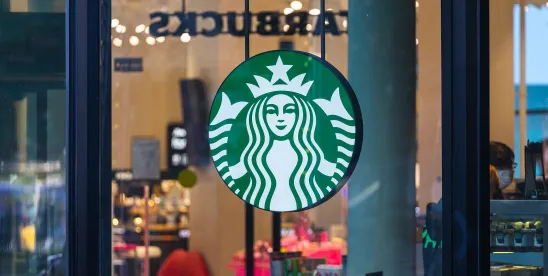In Starbucks v. McKinney, the Supreme Court of the United States clarified the standard for injunctive relief under Section 10(j) of the National Labor Relations Act (NLRA or the “Act”).
The 9-0 decision, authored by Justice Thomas, with Justice Jackson concurring in the judgment and dissenting in part, held that appropriate standard is the four-part test for preliminary injunctive relief articulated in Winter v Natural Resources Defense Council, Inc. 555 U.S. 7 (2008). That test requires the party seeking the injunction to show “[1] he is likely to succeed on the merits, [2] that he is likely to suffer irreparable harm in the absence of preliminary relief, [3] that the balance of equities tips in his favor, and [4] that an injunction is in the public interest.” Winter, 555 U. S., at 20, 22. This represents a significant change and one that is likely to make it more difficult for the National Labor Relations Board (NLRB or the “Board”) to obtain injunctive relief while an unfair labor practice claim is being litigated.
While four circuits – the Fourth, Seventh, Eighth, and Ninth – already followed the four-factor preliminary injunction test, five other circuits – the Second, Third, Fifth, Tenth and Eleventh, and the Sixth Circuit, where Starbucks v. McKinney originated – had applied a less demanding standard that only required the NLRB to demonstrate that the Board’s Regional Director had concluded that “there is reasonable cause to believe that unfair labor practices have occurred,” and whether injunctive relief is “just and proper.” This two-factor test versus the four-factor test was seen by many to be a lower barrier to injunctive relief.
The impact of this decision, beyond resolving a split among the Circuits, will be to establish a clear and consistent standard for district courts to apply when considering applications for Section 10(j) injunctive relief in unfair labor practice cases. The decision makes clear that the mere fact that an NLRB Regional Director contends that injunctive relief is appropriate will no longer serve as grounds for the issuance of such an injunction.
What is Section 10(j) and How is it Used?
Section 10(j) of the Act authorizes the NLRB to seek injunctive relief in the U.S. District Court before there is a final determination that an employer has committed an unfair labor practice (ULP). Historically, such injunctions were rarely sought and, when pursued, were intended to restore the status quo while a ULP case winds its way through the NLRB’s frequently slow internal adjudicative process.
A typical ULP charge is investigated by one of the Board’s Regional Offices, after which, a Regional Director reviews the facts and the law and decides whether to dismiss the charge, defer further processing, or find merit to some or all of the allegations in the charge and issue a Complaint and refer the case to hearing before an NLRB Administrative Law Judge (ALJ). Following such a hearing, the ALJ issues a decision and proposed remedial order, which can be appealed to the five-member Board in Washington, DC, for review, and the Board can issue a final Board Order. Such final Board Orders are not self-enforcing. This means that after the Board issues such an order, absent voluntary compliance, the Board can seek enforcement of the order at the Circuit Court, or a losing party can seek to have the order denied enforcement.
When the Board seeks Section 10(j) interim relief, it will only petition the District Court after a Regional Director finds merit to a case. Historically, such relief has typically been pursued in the case of particularly egregious violations of the Act, such as when an employer fires an outspoken union-supporting employee in the infancy of an organizing campaign. In such “nip in the bud” cases, the General Counsel asks the Board for authority to seek a Section 10(j) injunction in Federal District Court seeking an order requiring the employer to re-hire the employee and to cease other ULP activity while the administrative hearing before the ALJ and the Board review process plays out. The irreparable harm, it is argued, is the effect that the employer’s alleged unlawful firing of a union-supporting employee and/or other ULP activity would have on the union’s efforts to organize where employees might fear the same fate if they support the union.
The current Biden-appointed General Counsel, Jennifer Abruzzo, has made the use of Section 10(j) injunctive relief a cornerstone in her efforts to assist unions through Agency action. Section 10(j) petitions have historically been rarely sought, but the Board has recently been seeking these petitions at a higher rate than in the past. See GC Memorandum 24-03 at pages 10-11.
The Supreme Court’s Decision
The Supreme Court’s decision in Starbucks v. McKinney effectively raises the standard for District Courts when analyzing a request from the NLRB for a preliminary injunction under Section 10(j). In certain circuits, including the Sixth and Second, the two-factor standard was a low bar to clear. It required, first, a showing of reasonable cause to believe that the statute had been violated, a rather low bar that could be cleared by showing that the Regional Director found merit to the underlying charge and decided to issue a Complaint. And second, that the injunctive relief was “just and proper,” which the Sixth Circuit permitted the Board to establish by demonstrating the relief was “necessary to return the parties to [the] status quo pending the Board’s proceedings in order to protect the Board’s remedial powers under the NLRA.” Starbucks v. McKinney 602 U.S. slip op. at 3 (internal citations omitted).
That lower standard essentially functioned, Starbucks argued, as a rubber stamp enabling the NLRB to seek and obtain injunctive relief in the District Courts in certain circuits by clearing a much lower bar than in other circuits that applied the more traditional four-pronged standard for granting injunctive relief.
The Supreme Court agreed and, going forward, in all Circuits, the NLRB will have to satisfy the four-pronged standard, which will require the Board to establish that 1) the NLRB is likely to succeed on the merits versus the lower reasonable cause standard, 2) there is a likelihood of irreparable harm in the absence of preliminary relief, 3) the balance of equities tips in the petitioner’s favor, and 4) an injunction is in the public interest.
To be sure, the Court’s decision, making clear that the standard for issuance of a Section 10(j) injunction is that which District Courts apply in most other injunction proceedings, should mean that employers will have a clearer path to oppose Board applications for injunctive relief and the NLRB will have to meet a higher standard wherever they seek such relief. However, it remains to be seen whether the Board’s General Counsel and/or the current five-member Board, a majority of whom were nominated by President Biden, will be deterred in seeking Section 10(j) relief given that the Courts are likely to be less amenable to granting such relief.
Also notable is that employer’s opposing Board petitions for Section 10(j) petitions have also had recent success in establishing a right to limited expedited discovery, when the Board seeks Section 10(j) relief, particularly to examine the role the Union played in eroding its own support. See Leslie v. Starbucks Corp., No. 23-1194 (2d Cir. May 15, 2024). This week, the Second Circuit also rejected a District Court’s grant of a Section 10(j) injunction against Amazon, where the lower court, applying the Second Circuit’s two-pronged Section 10(j) standard, did not properly articulate the rationale for its finding that such relief was “just and proper.” Poor v. Amazon.Com Services LLC, No. 22-3182 (2d Cir. June 12, 2024).





 />i
/>i

